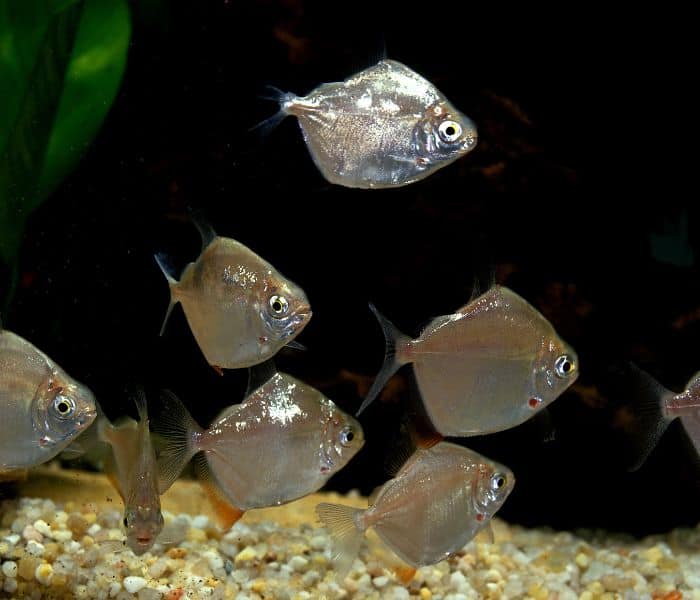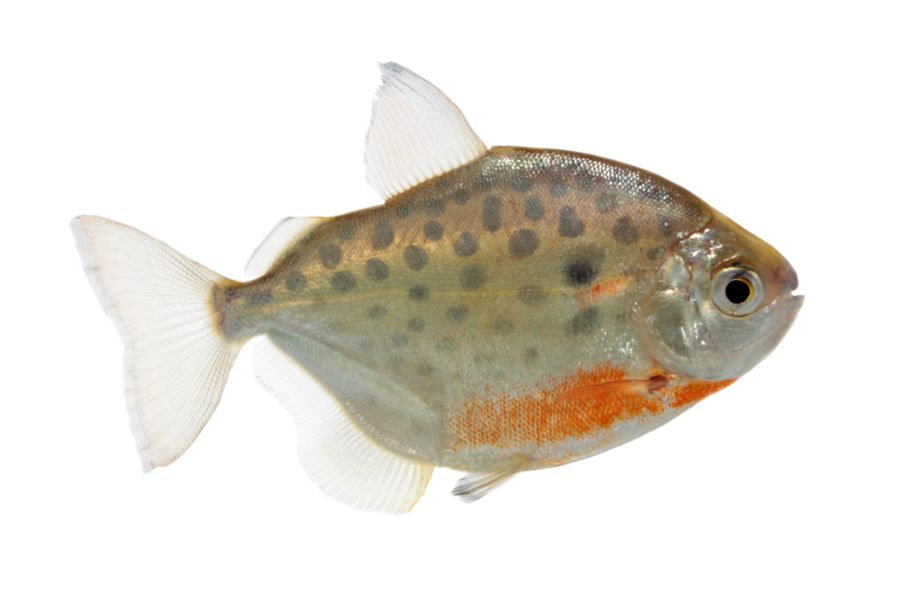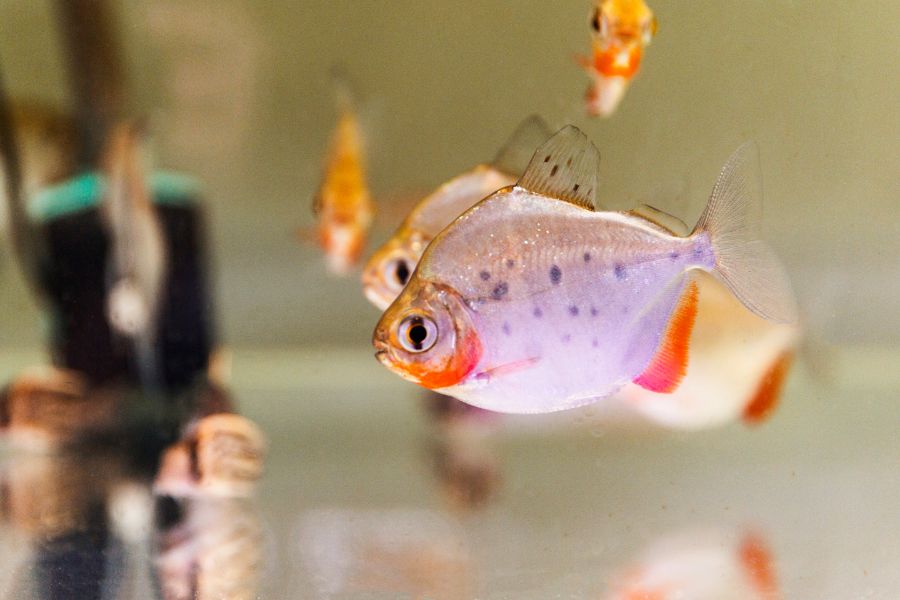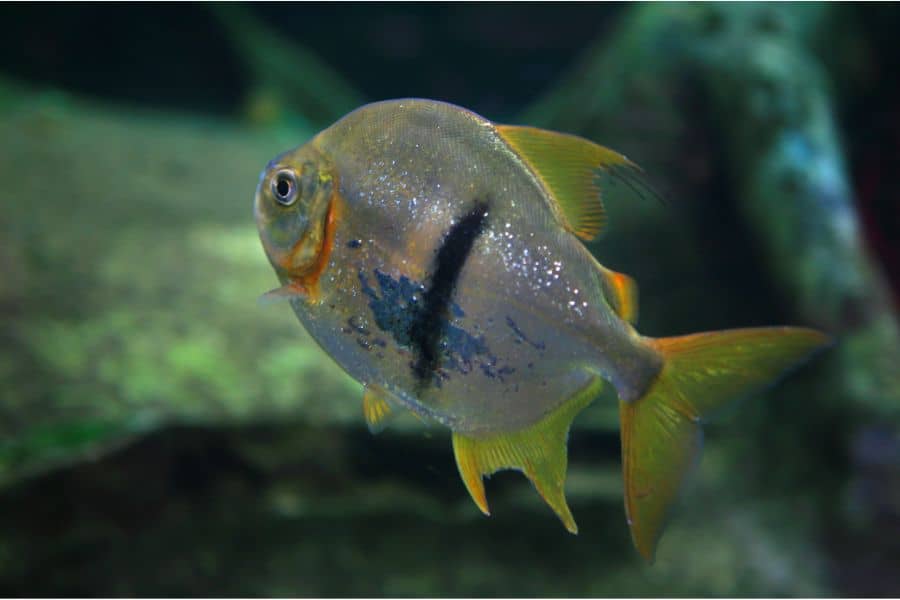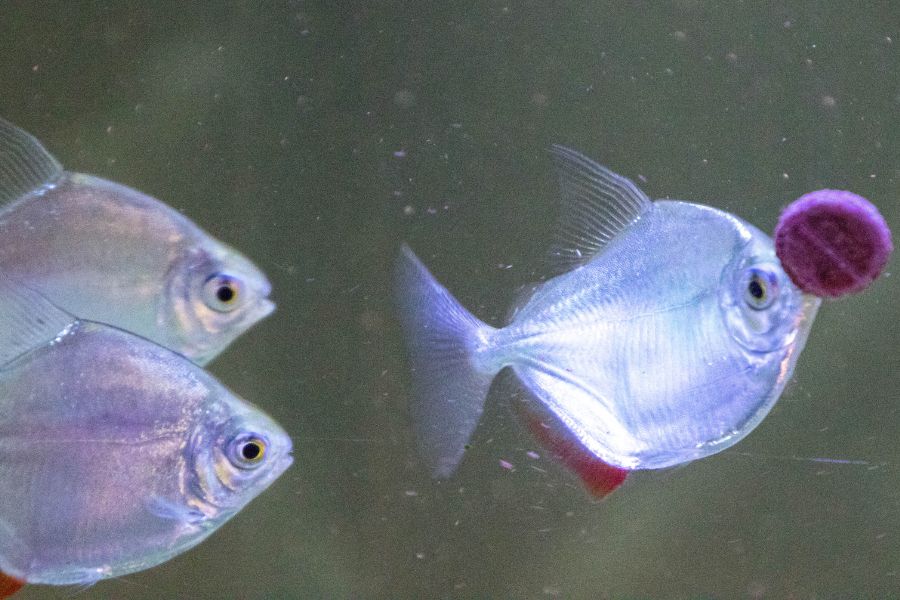Shining and shimmering with an overall appearance like those of newly minted coins. That’s how we easily associate our identification with the Silver Dollar Fish.
But what else do you know about them? Aside from identification, perhaps you may know a thing or two and do not worry because you are not alone. Surprisingly, only a few have in-depth knowledge about this popular freshwater aquarium fish.
In this article, we will elevate your knowledge and become a more experienced aquarist by learning the biology, growth requirements, care and maintenance of Silver Dollar Fish.
Types of Silver Dollar Fish
When we speak of the Silver Dollar Fish, we are not just talking about a single species. Currently, we have 11 recognized species of Silver Dollar Fish, and most of them are traded in the aquarium industry.
Metynnis Argenteus
Commonly referred to as the Common Silver Dollar Fish, this species is the most common type sold in the aquarium hobby, and they fundamentally represent the entire family of Silver Dollar Fish.
Their bodies are round and compressed. While they have a uniform silvery blue color, the Common Silver Dollar Fish has a dash of faint red in their fins and gill openings like those of tetras, thus its alternate name: the Silver Dollar Tetra.
Metynnis Hypsauchen
This species is almost identical to M. argenteus, and they are often mistakenly identified as the Common Silver Dollar Fish.
There are three key points to differentiate this species from M. argenteus.
First is when both species are still in their juvenile stage. This species has faint vertical lines, while M. argenteus is plain and silvery. However, be aware that the lines are temporary and fade away as they mature.
Second, look at their round bodies, and you will see that this species has a deeper shape compared to the flat profile of M. argenteus.
And lastly, M. argenteus is widely available, while this species is not (though not rare).
Metynnis Lippincottianus
This species has several black spots on its body, thus earning its common name: the Spotted Silver Dollar Fish. If you look closely at their spots, you will see that the dots are big at their upper dorsal fin and get smaller as it goes down ventrally to their anal fin.
Myleus Rubripinnis
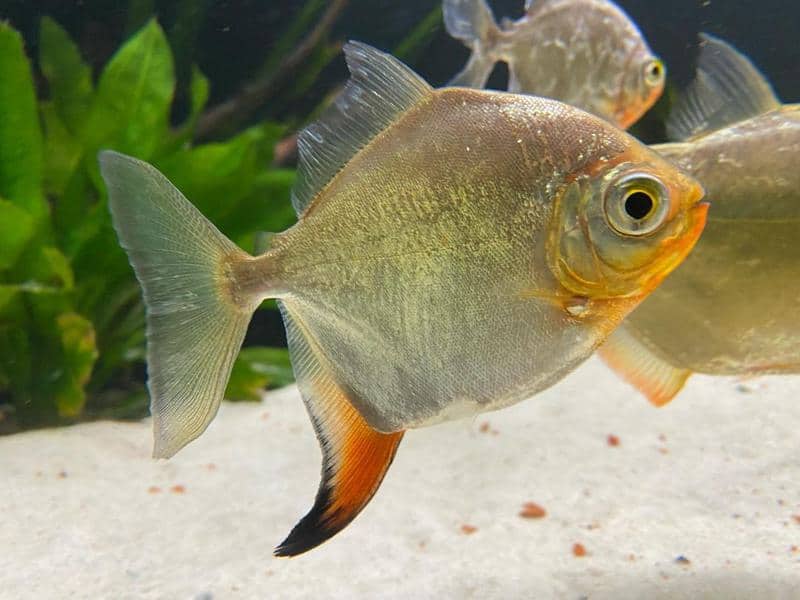
Amongst the family of Silver Dollar Fish, this species is one of the easiest to identify since all you need to do is to look at their anal fin.
Aside from being elongated and highly developed, you will see that their anal fin is colored red with a black outline, thus this species is commonly called the Red Hook Silver Dollar Fish.
Metynnis Maculatus
This species combines the features of the Common (M. argenteus) and the Spotted Silver Dollar Fish (M. lippincottianus). It has black spots scattered all over its body with its fins and gill covers colored red.
Metynnis Mola
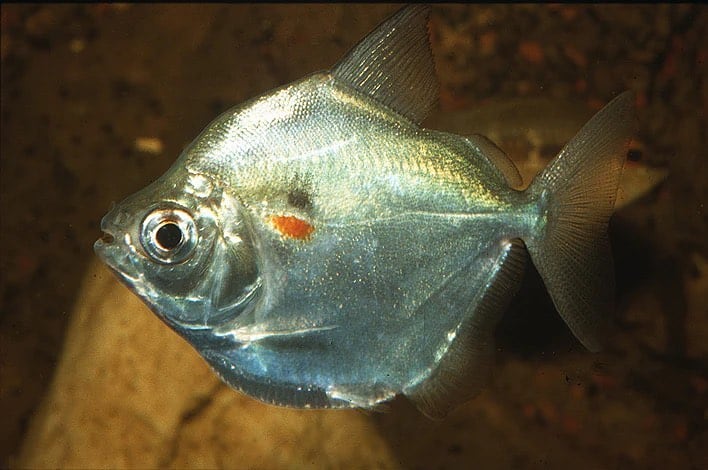
This species looks similar to your Common Silver Dollar Fish, but only its belly is bulging and convex. Aside from its distinct tummy shape, its body color is intensely silver and more radiant that it reflects rainbow colors when hit by light, thus its common name: the Pearl Silver Dollar Fish.
Metynnis Fasciatus
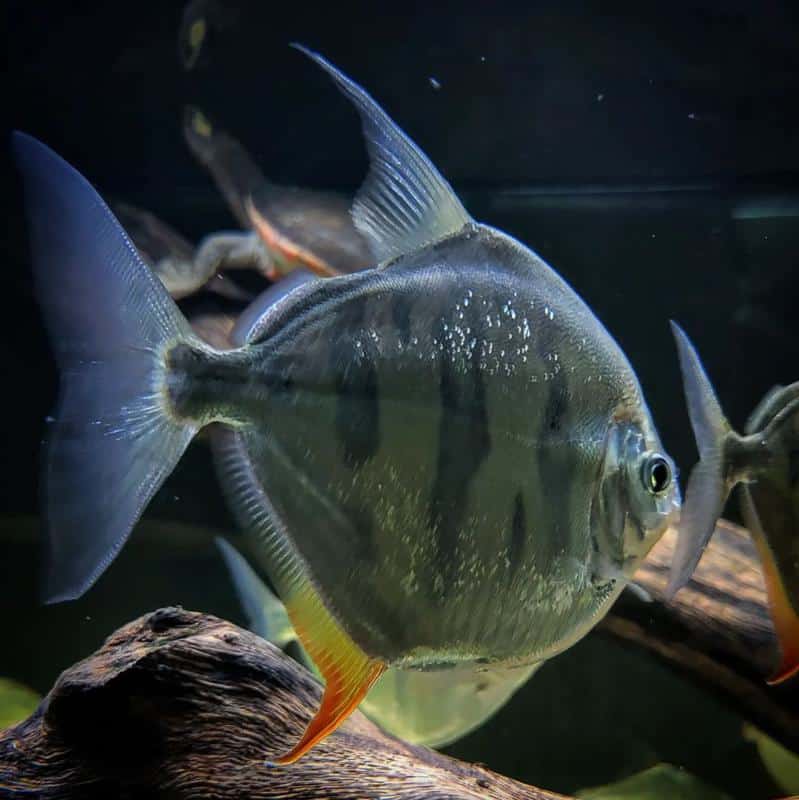
Similar to the stripes of land tigers, this species has a distinct black stripe pattern that runs from their dorsal fin down to their anal fin, thus its common name: the Tiger Silver Dollar Fish.
The stripe markings of this species are so unique that no two patterns are the same. The stripes are like a fingerprint for each individual fish.
The fact is that you can individually name your fish based on their stripe pattern. In my case, one of my Tiger Silver Dollar Fish is named Sarge due to its 3 distinct lines that are similar to a rank insignia of an Army Sergeant.
Myleus Schomburgkii
This is another species of Silver Dollar Fish that can be identified easily. Commonly called the Black-Barred Silver Dollar Fish, this fish has one solid black vertical line at the central portion of its body.
Mylossoma Aureum
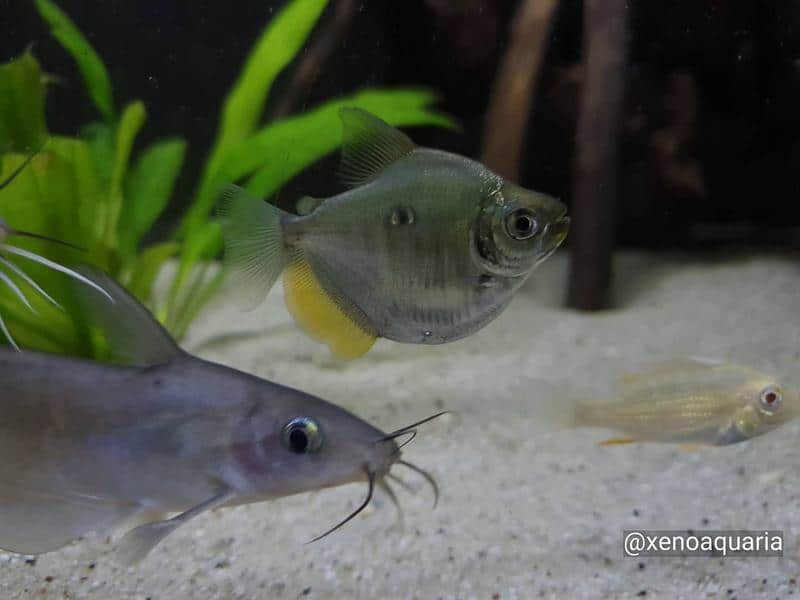
Not all species of Silver Dollar Fish are identified using spots and stripes. Some are based on distinct body structures, like the bulging tummy of a Pearl Silver Dollar Fish.
In the case of this species, it is their upper dorsal side that is bulging. Taking a closer look, you will see how their dorsal mass is extended creating a hunchback effect.
Common Traits of Silver Dollar Fish
Despite having multiple species, all types of Silver Dollar Fish share the same common trait, like:
Schooling Preference
All species of Silver Dollar Fish are non-solitary. They prefer and thrive in groups of at least six individuals for a 20-gallon tank.
When they are in a group (called school), they feel safe, protected, and their chances of getting stressed out while living in a confined space is less likely to occur.
The good thing with the schooling preference of Silver Dollar Fish is that it also increases the aesthetic beauty of your tank. In most cases, your Silver Dollar Fish will swim in a synchronized and coordinated manner which is very pleasing to see.
Diurnal Swimmers
Silver Dollar Fish are highly active during the daytime. Triggered by the presence of bright light, they actively swim in school. However, at night or when you turn off your aquarium lights, your Silver Dollar Fish will turn into their rest mode by initially reducing their swimming activity until they find a hidden spot and remain still.
Size
Silver Dollar Fish got its name from the silver dollar coin, and it is not surprising if we also associate them with its size.
Well, this is only true for those sold in pet shops, as the majority that are for sale are still juveniles. However, when you take home and keep Silver Dollar Fish while providing them with their ideal growing conditions, they will grow larger than most silver coins in circulation.
For comparison within their family, the Common Silver Dollar Fish (M. argenteus) is the smallest at 15 cm (6 in) long, while the largest is the Red Hook Silver Dollar Fish (M. rubripinnis) that can reach a maximum size of up to 56 cm (22 in) in length.
Peaceful Community Residents
One of the misconceptions about Silver Dollar Fish is that they are aggressive. No, they are not.
The fact is that they are generally peaceful, and they do well in a community tank. This is on the assumption that there is enough food and ample space for the school to swim freely.
Well Developed Dental System
Some species of Silver Dollar Fish are exclusively herbivores (like M. hypsauchen and M. maculatus), while some are omnivores (like M. rubripinnis) feeding on both plant and animal matter.
Whether they are herbivores or omnivores, what is common among all species of Silver Dollar fish is their well-developed dental system.
They have multiple rows of teeth having both incisors for cutting and molars for grinding.
Piranha Cousins
Actively swimming in groups with well-developed and sharp teeth, we cannot help but associate Silver Dollar Fish with the ferocious Piranha.
Yes, both fish are closely related, share the same ancestry, and belong to the same Characidae family of fish. Although they have many similarities when it comes to physical attributes, Piranhas and Silver Dollar Fish are totally different when it comes to behavior and feeding habits.
Growth Requirements
Despite being a hardy tank resident, Silver Dollar Fish has a preferred water condition for them to thrive, flourish and live to their expectations.
Tank Size
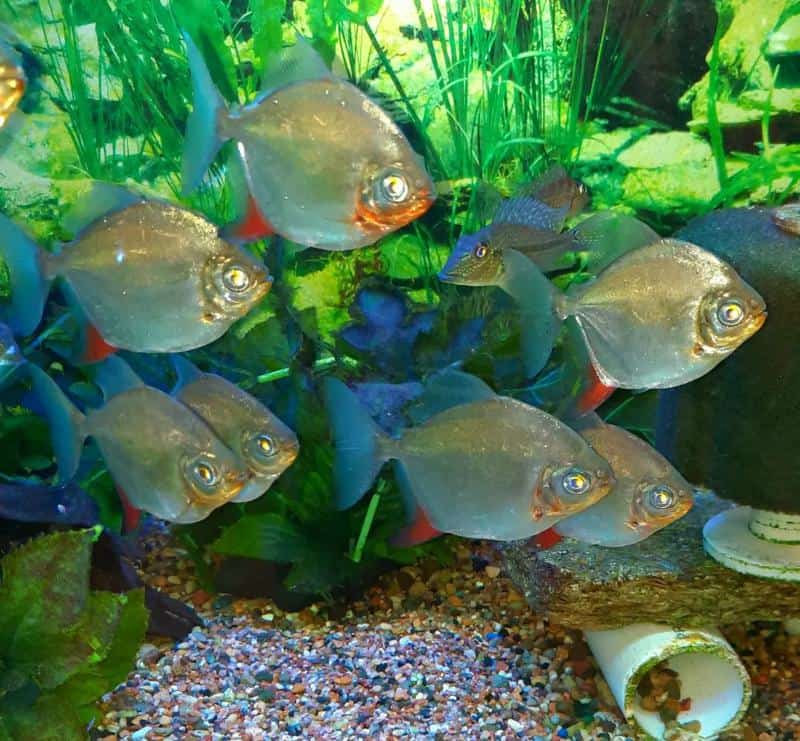
Since the attainable maximum length varies per species, tank size will also vary. For small-sized species (like M. argenteus), a 20-gallon tank is sufficient enough to provide space for a school of 6 individuals. Large-sized species of Silver Dollar Fish (like M. rubripinnis) require larger tanks and a 75-gallon aquarium can easily accommodate their swimming school.
Tropical Waters
With their South American origins, all species of Silver Dollar Fish are tropical. They thrive in warm waters ranging from 24 to 28 C (75 to 82 F).
While they can tolerate slightly colder waters, we do not recommend it since it reduces their appetite, they become sluggish and weakens their immune system.
Moderate Water Flow
Stagnant or non-moving waters are a no-no for your Silver Dollar Fish. To be stimulated and swim actively, they need moderate water flow. But not too much water flow that they struggle to swim against the current.
Slightly Acidic Waters
The natural environment of Silver Dollar Fish in the Amazon River Basin is slightly acidic. To mimic these conditions, you must maintain your pH level anywhere from 5.0 to 7.0.
Try not to make your waters alkaline. It can impair the respiration of your Silver Dollar Fish. Remember that alkaline waters have high dissolved minerals which makes the extraction of dissolved oxygen by your Silver Dollar Fish difficult.
Summary of Silver Dollar Fish Growth Requirements
| Parameters | Range |
| Minimum Tank Size | 20 gallons (for small species)
75 gallons (for large species) |
| Temperature | 24 to 28 C (75 to 82 F) |
| Water flow | Moderate |
| pH | 5.0 – 7.0 |
| Hardness | 4 to 18 dGH |
Silver Dollar Fish Food
To support their active swimming traits, Silver Dollar Fish requires a lot of food for energy. But you don’t just give them anything since the different types of Silver Dollar Fish need specific foods.
Food Items for Herbivorous Silver Dollar Fish
If the species of Silver Dollar Fish you choose is a herbivore, you can give them fresh vegetables like lettuce, peas, squash and spinach. The key for a successful vegetable feeding is to slice them in small portions that can fit the size of their mouth.
If you’re not fond of keeping fresh produce or just don’t like vegetables, you can still satisfy the cravings of your herbivorous Silver Dollar Fish by giving them veggie tablets.
Food Items for Omnivorous Silver Dollar Fish
On top of vegetables, omnivorous types of Silver Dollar Fish need meaty treats like mosquito larvae, bloodworms, brine shrimp, and commercially available feeds. Don’t worry if it’s a sinker or a floater since the active swimming traits of your Silver Dollar Fish can easily chase their food.
Feeding Ration
It doesn’t imply that the big appetite of Silver Dollar Fish means you will give them unlimited food. Please do not, and never overfeed them since it can cause illnesses and deteriorate your water quality.
Ideally, you only give what they can consume in a few minutes.
Feeding Frequency
The frequency of feeding in Silver Dollar Fish will vary depending on their life stage.
Since they have higher metabolic rates, juvenile Silver Dollar Fish needs to be fed 2 to 3 times a day. As they mature, their metabolic activity decreases and they only need to eat once or twice daily.
Breeding and Propagation
With conducive parameters and proper conditioning, Silver Dollar Fish is one of the many freshwater fish that can breed in an aquarium setting.
One of the reasons why the ideal stocking of Silver Dollar Fish is at least six individuals per tank is that it is from this group that you choose your breeders. They will reach sexual maturity after one year in captivity.
Selecting a Breeding Pair
From your school of Silver Dollar Fish, you need to choose one male and one female to become your breeding pair.
To give you a guide in determining the sex, females are generally larger than males. As their breeding season approaches, the stomachs of females become rounder, while in males, their anal fins become more pointed and elongated.
Conditioning a Breeding Pair
Once you have selected a breeding pair, transfer them to a breeding tank. To prepare them for the upcoming spawning, you need to condition them by giving them a diversity of high-quality foods. Do the food conditioning anywhere from 7 to 10 days or until you see the anatomical signs that they are ready to spawn.
Mimicking the Breeding Season
Silver Dollar Fish needs environmental triggers for them to spawn. In the wild, spawning is triggered by the arrival of the rainy season.
For you to induce their spawning in a breeding tank, you need to mimic their breeding season by warming the water anywhere from 25 to 28 C (78 – 82 F) and making it softer (8 dGH or below).
The Spawning Process
Fertilization in Silver Dollar Fish is external. When a female releases her eggs, the male will swim alongside the female allowing him to release his sperm called milt in the water and fertilize the eggs.
Do not be overwhelmed during the spawning process since it can be chaotic. A single female is capable of releasing 2,000 eggs (1 to 2 mm in diameter), while the milt of male causes the water to become turbid.
As the eggs get fertilized, they settle at the substrate and will hatch after 3 days to become a baby fry. It will take over a week before they are totally out of their egg casing and start to swim freely.
From then on, you can feed both your breeding pair and their babies with live tiny foods like infusoria and brine shrimp.
Silver Dollar Fish Ideal Tank Mates
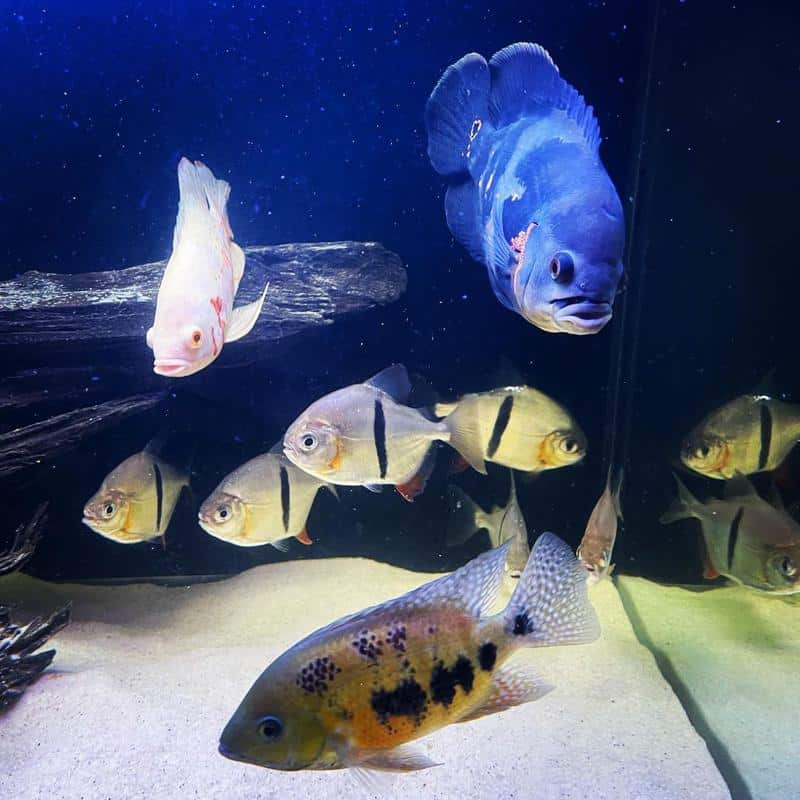
Even if Silver Dollar Fish does well in a community tank, not all fish are compatible with them. Their ideal tank mate should be peaceful, similar in size, schooling in behavior, omnivore (herbivore the better), and share the same water parameters.
Some of their ideal tank mates include mid-dwellers (like Bala Sharks, Angelfish, Giant Danios, and Redtail Sharks) or bottom dwellers (like Kuhli Loach, Plecos, and Cory Catfish).
Also Read: Australian Rainbow Fish
Silver Dollar Fish: FAQs
Can I Keep 1 Silver Dollar Fish?
Yes, but not recommended. Remember that Silver Dollar Fish are non-solitary and they prefer to be in a school of at least 6 individuals. If you keep a single Silver Dollar Fish in a tank, chances are they become stressed out and will become aggressive towards other fish.
What Is the Lifespan of Silver Dollar Fish?
Silver Dollar Fish thriving in their wild habitat can live anywhere from 5 to 10 years. They can live longer in an aquarium setting, provided the tank is well maintained, and proper care is given to your fish.
What Is the Best Hiding Spot for Silver Dollar Fish?
Live aquarium plants can be a good hiding spot for Silver Dollar Fish. However, with their active swimming traits, plants can easily be uprooted, and not to mention they are part of the diet in the herbivorous species of Silver Dollar Fish.
This is one of the few times we recommend heavy plastic decorations as hiding spots for your Silver Dollar Fish. Not only are they inedible, they are sturdy enough to withstand accidental bumping of your fish.
What Is Ideal Substrate for Silver Dollar Fish
Providing a substrate is not a primary requirement in keeping Silver Dollar Fish. However, to increase the aesthetic value of your tank, you can use dark-colored sand or gravel. The dark coloration of your substrate will enhance the silvery shine of your fish.
Final Thoughts
We hope we have debunked most (if not all) of the misconceptions about Silver Dollar Fish.
Now that you know that while they are taxonomically related to Piranhas, their overall behavior has nothing to do with being a ferocious fish.
With this, it’s time to sit in front of your tank and enjoy the dynamic and active schooling of your Silver Dollar Fish. Well, in my case, I enjoyed it so much up to the point that I was hypnotized by how synchronized they swim.
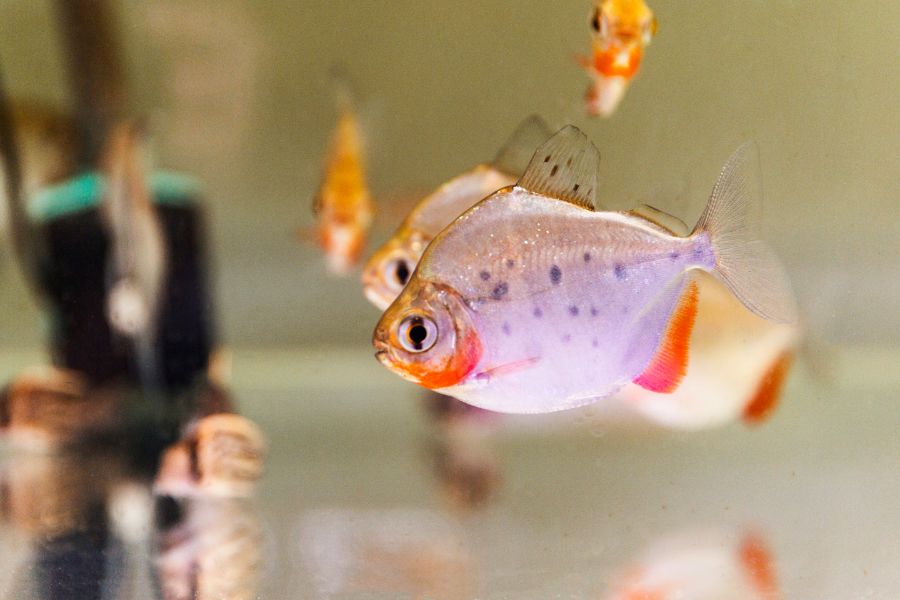
.jpg)
